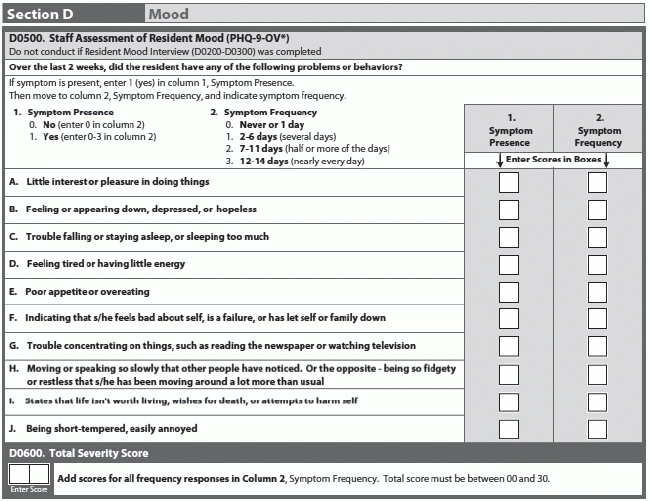What To Keep In Mind When Performing Staff Assessment Of Resident Mood
Why you’re not doing the standard PHQ-9© for D0500.
Like the Resident Mood Interview in D0200, the Staff Assessment of Resident Mood (D0500) is based on the Patient Health Questionnaire, better known as the PHQ-9©. But there are some rather distinct differences between the format for the resident interview and the staff assessment that you should pay attention to.
“Even something as simple as the [PHQ-9©] — which is all of nine questions — can help improve patient outcomes,” noted John Grohol, Psy.D., founder and CEO of PsychCentral, in a recent PsychCentral.com blog post. The PHQ-9 supplements clinical judgment with additional valuable information.
When to Do the Staff Assessment
“There are some residents who end up needing to have a staff assessment of mood because they’re unable to complete the PHQ-9©,” said Debra Saliba, MD, MPH, director of the UCLA/Jewish Home Borun Center for Gerontological Research in Los Angeles, in a recent CMS instructional session. “They can still have a mood disorder even if they’re not able to make themselves understood some of the time, or if they were unable to complete the PHQ-9©.”
“You’re only going to do the staff assessment for those residents who are unable to make themselves understood at least some of the time or who are unable to complete the PHQ-9© despite your best efforts to work with them to get through it,” Saliba noted.
Take heart: Even unsuccessful attempted interviews still give you some information that you wouldn’t have had if you hadn’t used such concrete, systematic interviews with that resident, stressed Saliba. So if the resident becomes hostile and unwilling to answer questions, you’ve learned something by observing that defensiveness. “So you haven’t wasted your time, but you do need to go back and do the staff assessment.”
For those few residents who can’t complete the PHQ-9© interview, you need to really talk to staff across all shifts who really know the resident best, Saliba instructed. And if the resident has “been in the facility for less than 14 days when you’re doing this assessment, then you’re going to need to talk to the family or significant other. You’re going to need to review the transfer records.”
Remember the Different Look-Back Period
You don’t have the standard seven-day look-back period for the mood assessment. “The look-back period for this item is different from other items; it’s 14 days,” Saliba noted. This is because a mood disorder “needs to have been present and fairly persistent for two weeks in order for it to be considered a mood disorder.”
Also: “You’re going to select the higher-frequency response because you’re screening to identify people in need,” Saliba said. “You’re going to add up the symptom frequency from column 2 and that’s what’s going to go in D0600 for reporting a total severity score.” Just like the resident interview, you don’t add in the values from column 1 for the total severity score — you’re adding up the values only from column 2.
Heads Up: Nine Becomes 10
And instead of having just the nine items as in the resident interview, the staff assessment has 10 items. “The one thing that’s different on the observational version is that we added an irritability item,” Saliba stated.
“But because we have an additional item, the score can be as high as 30,” Saliba pointed out. “So instead of going from 00 to 27, it can go from 00 to 30.”
Another thing: “Remember that just because you’re coding presence doesn’t mean that you’re being asked to diagnose mood disorder or depression,” Saliba added.


